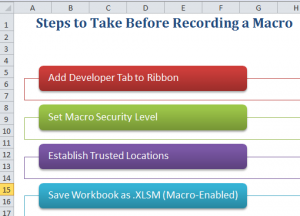 This is Part 3 in my series, “How to Record, Run, and Edit Macros in Excel.” In this episode, I demonstrate how to open up the VBA (Visual Basic for Applications) Code window and then:
This is Part 3 in my series, “How to Record, Run, and Edit Macros in Excel.” In this episode, I demonstrate how to open up the VBA (Visual Basic for Applications) Code window and then:
- Step Into each line of the code – using the F8 Keyboard Shortcut – to examine how the Macro Behaves
- Use the ‘ (apostrophe) to “remark out” one line of the code. This will quickly change the macro to use Relative Cell Referencing rather than Absolute Cell Referencing!
- Edit one line of the VBA Code to change the “text” that you want your macro to enter.
I created this series of Excel Tutorials to assist my viewers to “get started on the right path” when they first start to experiment with the power of Macros in Excel. I welcome your feedback on this – or any – Excel tutorial that I have published.
Step Into a Macro
When you run a Macro, it is impossible to “trouble shoot” or examine the individual actions that occur. In this lesson, I demonstrate how to use “Step Into” mode – with the keyboard Shortcut F8 – to run each line of the VBA Code step-by-step. Using Step Mode with any macro is a great way to learn how top efficiently write, record, or edit a macro.
Secure Online Shopping for Excel Training Resources
I welcome you to visit my Secure Online Shopping Site – http://shop.thecompanyrocks.com – where you can learn about the range of video training resources that I offer.
Watch Excel Tutorial in High Definition
Follow this link to watch my tutorial in High Definition on my YouTube Channel – DannyRocksExcels.


